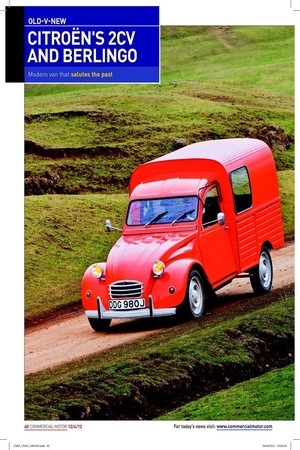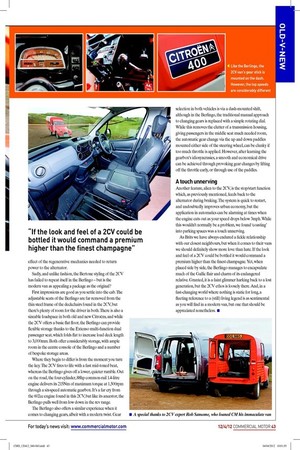OLD-V-NEW
Page 32

Page 33

Page 34

Page 35

If you've noticed an error in this article please click here to report it so we can fix it.
CITROËN'S 2CV
AND BERLINGO
Modern van that salutes the past
ollowing a class act
Citroën’s 2CV and Berlingo are more similar than you think – until you turn on the ignition key
Words: George Barrow / Images: Tom Lee Tin snail, Dolly, or Deux Chevaux. Call it what you will, the Citroën 2CV is a cultural design and automotive icon, so after more than 40 years in production it is no surprise that nearly four million cars and two million vans were made. While DVLA igures show that around 3,500 2CV cars are still licensed on UK roads, and many more are SORN, just a handful of vans are on the database. Yet despite nearing extinction on these shores, the modern van driver owes a debt of gratitude to the 2CV van, because it is the ancestral root of many of the most current crop of LCVs.
With a compact cab backing onto a boxy loadspace offering good volume and sizeable payload, the shape and feel of many modern French models such as the Renault Kangoo and Citroën Berlingo owe their heritage to the 2CV Fourgonnette (the French word for delivery van).
However, times have changed and technology has certainly moved on from the 602cc engine found in this particular AKS 400 model 2CV.
Efforts are being made across the automotive industry to cut engine emissions, and many manufacturers have hit upon stop/start as a simple solution to reducing CO2 output when vehicles are stationary. Citroën’s latest Berlingo light van adopts that technology as part of its new micro-hybrid drivetrain system itted to Airdream models. With a regenerative braking system that actually only feeds power
back to the alternator during braking, allowing alternator load on the engine to be decreased at other times, the Berlingo e-HDi90 Airdream is signiicantly more advanced than the 2CV’s inboard front brake design. Yet both are innovative solutions to help solve a problem.
The Berlingo’s regenerative braking helps the modern Citroën achieve an impressive 123g/km of CO2 emissions and a claimed 60.1mpg, while the 2CV’s brake design limited the unsprung mass of the vehicle, improving handling and, more importantly, allowing the vehicle’s famed suspension performance and travel. Despite nearly 40 years of engineering advancements separating the test vehicles, these two deining characteristics of old and new unify our Citroëns.
Fuel consumption
Emission objectives aside, the Fourgonnette’s original design closely apes the Berlingo’s current goals. The 2CV – which was designed to convey a basket of eggs across a ploughed ield without any breakages – was expected to carry four farmers (or in the case of a van, two and a 400kg load) to market at a fuel consumption rate of more than 70mpg. More than 60 years after the irst 2CV car and 2CV van models were produced, that emphasis on economy has returned to the latest Berlingo, and so, too, has the inboard braking system – albeit only as a side effect of the regenerative mechanics needed to return power to the alternator.
Sadly, and unlike fashion, the Bertone styling of the 2CV has failed to repeat itself in the Berlingo – but is the modern van as appealing a package as the original?
First impressions are good as you settle into the cab. The adjustable seats of the Berlingo are far removed from the thin steel frame of the deckchairs found in the 2CV, but there’s plenty of room for the driver in both. There is also a sizeable loadspace in both old and new Citroëns, and while the 2CV offers a basic lat loor, the Berlingo can provide lexible storage thanks to the Extenso multi-function dual passenger seat, which folds lat to increase load deck length to 3,000mm. Both offer considerably storage, with ample room in the centre console of the Berlingo and a number of bespoke storage areas.
Where they begin to differ is from the moment you turn the key. The 2CV ires to life with a fast mid-toned beat, whereas the Berlingo gives off a lower, quieter rumble. Out on the road, the four-cylinder, 88hp common-rail 1.4-litre engine delivers its 215Nm of maximum torque at 1,500rpm through a six-speed automatic gearbox. It’s a far cry from the 602cc engine found in this 2CV, but like its ancestor, the Berlingo pulls well from low down in the rev range.
The Berlingo also offers a similar experience when it selection in both vehicles is via a dash-mounted shift, although in the Berlingo, the traditional manual approach to changing gears is replaced with a simple rotating dial. While this removes the clutter of a transmission housing, giving passengers in the middle seat much needed room, the automatic gear change via the up and down paddles mounted either side of the steering wheel, can be clunky if too much throttle is applied. However, after learning the gearbox’s idiosyncrasies, a smooth and economical drive can be achieved through provoking gear changes by lifting off the throttle early, or through use of the paddles.
A touch unnerving
Another feature, alien to the 2CV, is the stop/start function which, as previously mentioned, feeds back to the alternator during braking. The system is quick to restart, and undoubtedly improves urban economy, but the application in automatics can be alarming at times when the engine cuts out as your speed drops below 3mph. While this wouldn’t normally be a problem, we found ‘coasting’ into parking spaces was a touch unnerving.
As Brits we have always endured a ickle relationship with our closest neighbours, but when it comes to their vans we should deinitely show more love than hate. If the look and feel of a 2CV could be bottled it would command a premium higher than the inest champagne. Yet, when placed side by side, the Berlingo manages to encapsulate much of the Gallic lair and charm of its endangered relative. Granted, it is a faint glimmer harking back to a lost generation, but the 2CV ethos is loosely there. And, in a fast-changing world where nothing is static for long, a leeting reference to a (still) living legend is as sentimental as you will ind in a modern van, but one that should be appreciated nonetheless. ■











































